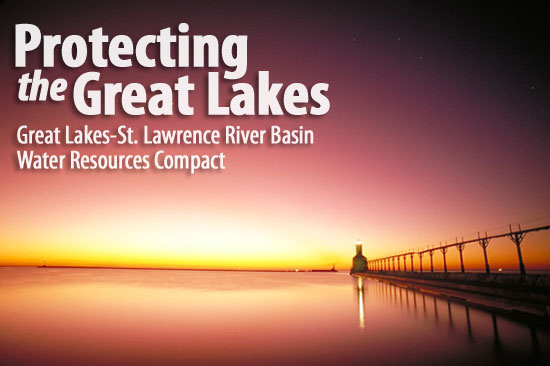
The Great Lakes-St. Lawrence River Basin Water Resources Compact is an agreement between eight Great Lakes states and two Canadian provinces to regulate diversion of water from the Great Lakes basin. The goal is to provide protection and sustainable use of the Great Lakes for future generations. The above photo shows a sunset framing the Michigan City Lighthouse on Lake Michigan.
FAQ
How is the Great Lakes Basin defined?
The Great Lakes Basin includes the waters within the geographic areas surrounding each body of water where water drains toward the Great Lakes, including groundwater.
How will diversions of water from the Great Lakes Basin be addressed under the Compact?
The Great Lakes Compact bans new or increased diversions with limited and strictly regulated exceptions.
Will existing withdrawals, diversions and consumptive uses have to meet the standards of the Compact?
The standards are intended for new or increased water withdrawals. Total water withdrawal capability currently registered for a significant water withdrawal facility and current diversions will be considered to be the existing approval amount for the Great Lakes Compact. Water conservation and efficiency programs will be developed by each state in order to reduce waste by all users.
Will the compact restrict economic growth within the Great Lakes Basin?
No. All the state governors want to see continued economic growth and understand that the sustainable use of waters within the Great Lakes Basin will play a critical role in the preservation of existing businesses and the creation of new jobs. Failure to responsibly manage the water within the basin would put future economic growth at risk.
What kind of conservation and efficiency measures will be required for approved water uses under the compact?
All proposals for new or increased water withdrawals must incorporate sound and economically feasible water conservation and efficiency measures in order to minimize the waste of water within the Great Lakes Basin. Indiana’s implementation of the Compact establishes that conservation and efficiency programs for the basin are voluntary and have been outlined in IDNR’s Report on Indiana Water Use Efficiency and Conservation. Voluntary water conservation and efficiency programs will also be encouraged statewide by the IDNR.
Can state legislatures make changes to the Compact language?
Because interstate compacts are essentially contracts between States, they must satisfy the customary requirements for valid contracts, including a "meeting of the minds" between the parties. No state may unilaterally alter the terms of a compact without jeopardizing the enforceability of the agreement. However, minor non-substantive changes (numbering or formatting, etc.) are acceptable.
History
Since 1983, the Council of Great Lakes Governors (CGLG) has worked together to protect the Great Lakes.
- 1985: Great Lakes Charter is created.
- 2001: Great Lakes Annex is updated.
- Dec. 13, 2005: The eight Great Lakes governors and the premiers of Quebec and Ontario signed the Great Lakes Water Management Agreement. They pledge to pursue enactment of the Great Lakes Compact in their legislatures.
- 2007-2008: All eight Great Lakes state legislatures ratified the compact. Legislative approval was completed by the U.S. Senate on August 1, 2008, and by the U.S. House of Representatives on September 23, 2008. The final step in the approval process happened on October 2, 2008, when President Bush signed a joint resolution of Congress endorsing the compact. The provisions of the Great Lakes Compact became effective on December 8, 2008, to ensure the protection and sustainable use of the Great Lakes for future generations.
State requirements
The primary requirements of the Great Lakes Compact can be found in Article 4 of Indiana Code (IC) 14-25-15 that includes the following:
- registration of all water withdrawals of 100,000 gallons-per-day or greater average in any 30 day period;
- development of water conservation and efficiency programs;
- regional review for new or increased consumptive uses from the Great Lakes of five million gallons-per-day or greater average in any 90 day period; and
- prohibition of diversions from the Great Lakes Basin except those for straddling communities, communities in straddling counties, and intra-basin transfers.
In addition to these general requirements, Indiana’s implementation of the compact is specified in Article 9 and includes the permitting of daily withdrawals in excess of any of the following, calculated on average over any 90 day period:
- five million gallons from Lake Michigan surface water;
- one hundred thousand gallons from a salmonid stream; and
- one million gallons from any other surface or ground water source.
Rule 312 IAC 6.2 that assists with Indiana’s implementation of the Compact under IC 14-25-15 became effective on September 1, 2014, and provides for the permitting of water withdrawals that exceed the thresholds listed above. Rule 312 IAC 6.2 also governs the following:
- sale or transfer of a facility with a baseline volume;
- registration of a withdrawal, consumptive use or diversion;
- issuance of an individual permit for a withdrawal, consumptive use, or diversion;
- issuance of a general permit for a withdrawal or a consumptive use; and
- voluntary and mandatory water conservation and efficiency programs..
In 1983, Indiana began a statewide registration and water use reporting program under IC 14-25-7-15. Detailed basin studies for the Indiana portion of the Great Lakes Basin (Lake Michigan Region, St. Joseph River Basin, Maumee River Basin) were done in the 1990s by the Indiana Department of Natural Resources Division of Water. These studies provide valuable background information on the region and the water resource. In addition, current and historic stream flow and ground water level data in the Great Lakes Basin are available from the United States Geological Survey at http://waterwatch.usgs.gov/ and http://groundwaterwatch.usgs.gov/default.asp, respectively.
More information
Department of Natural Resources,
Division of Water
877-928-3755 or
